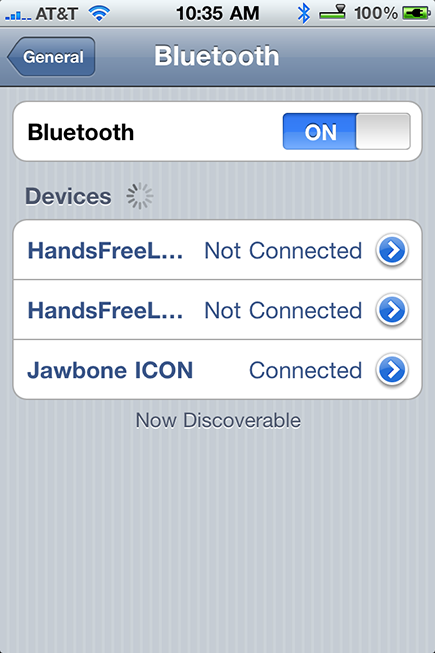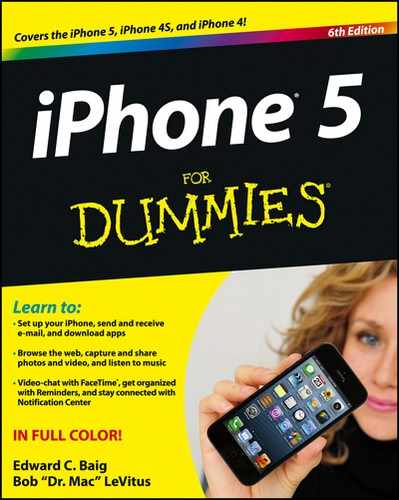Sky-High Settings
When you first open Settings, you see the scrollable list shown in Figure 14-1. In all but airplane mode (at the top of the list), a greater-than symbol (>) appears to the right of each listing. This symbol tells you that the listing has a bunch of options. Throughout this chapter, you tap the > symbol to check out those options.

Figure 14-1: Presenting lists of settings.
If you scroll down towards the bottom of the Settings list, you will see settings that pertain to Twitter and Facebook, and settings that pertain to some of the specific apps you’ve added to the iPhone, as shown in Figure 14-1, right. (See Chapter 15 for the scoop on third-party apps.)
Airplane mode
Using a cell phone on an airplane is a no-no. But there’s nothing verboten about using an iPod on a plane to listen to music, watch videos, and peek at pictures — at least, after the craft has reached cruising altitude.
So how do you take advantage of the iPhone’s built-in Music player (among other capabilities) while temporarily turning off its phone, e-mail, and Internet functions? The answer is, by turning on airplane mode.
To do so, merely tap airplane mode on the Settings screen to display On (rather than Off).
That act disables each of the iPhone’s wireless radios: Wi-Fi, EDGE, 3G, LTE (if applicable), and Bluetooth. While your iPhone is in airplane mode, you can’t make or receive calls, surf the web, or do anything else that requires an Internet connection. The good news is that airplane mode keeps your battery running longer — particularly useful if your flight is taking you halfway around the world.
 The appearance of a tiny airplane icon on the status bar in the top-left corner reminds you that airplane mode is turned on. Just remember to turn it off when you’re back on the ground.
The appearance of a tiny airplane icon on the status bar in the top-left corner reminds you that airplane mode is turned on. Just remember to turn it off when you’re back on the ground.
Wi-Fi
As we mention in Chapter 11, Wi-Fi is typically the fastest wireless network you can use to surf the web, send e-mail, and perform other Internet tricks on the iPhone. You use the Wi-Fi setting to determine which Wi-Fi networks are available to you and which one to exploit based on its signal.
Tap Wi-Fi, and you see any Wi-Fi networks in range, as shown in Figure 14-2.

Figure 14-2: Checking out your Wi-Fi options.
A signal-strength indicator can help you choose the network to connect to if more than one is listed; tap the appropriate Wi-Fi network when you reach a decision. If a network is password-protected, you see a lock icon.
You can also turn on or off the Ask to Join Networks setting. Networks that the iPhone is already familiar with are joined automatically, regardless of which one you choose. If the Ask feature is on, you’re asked before joining a new network. If it’s off, you have to select a network manually.
Sometimes, you may want to connect to a network that’s closed and not shown on the Wi-Fi list. If that’s the case, tap Other and use the keyboard to enter the network name. Then tap to choose the type of security setting the network is using (if any). Your choices are WEP, WPA, WPA2, WPA Enterprise, and WPA2 Enterprise. Again, it’s not exactly the friendliest terminology, but we figure that someone nearby can provide assistance.
Bluetooth
Of all the peculiar terms you may encounter in techdom, Bluetooth is one of our favorites. The name is derived from a tenth-century Danish king named Harald Blåtand, who, the story goes, helped unite warring factions. And, we’re told, Blåtand translates to Bluetooth in English. (Bluetooth is all about collaboration between different types of devices — get it?)
Blåtand was obviously ahead of his time. Although he never dialed a cell phone, he now has an entire short-range wireless technology named in his honor. On the iPhone, you can use Bluetooth to communicate wirelessly with a compatible Bluetooth headset or hands-free car kit. These optional headsets and kits are made by Apple and numerous others. They’ve become more of a big deal as a number of states and municipalities around the United States make it illegal to hold a phone to your mouth and ear to gab while you’re driving. To ensure that the iPhone works with one of these devices, it has to be wirelessly paired, or coupled, with the chosen device. With the optional iPhone Bluetooth headset that Apple sells, you can automatically pair the devices by placing the iPhone and headset in a dual dock (supplied with the headset), which you connect to your computer.
If you’re using a third-party accessory, follow the instructions that came with that headset or car kit so that it becomes discoverable, or ready to be paired with your iPhone. Then turn on Bluetooth in Settings so that the iPhone can find such nearby devices and the device can find the iPhone. Bluetooth works up to a range of about 30 feet.
 You know Bluetooth is turned on when you see the Bluetooth icon on the status bar. If the symbol is blue or white, the iPhone is communicating wirelessly with a connected device. (The color differences provide contrast to whatever is behind the icon.) If it’s gray, Bluetooth is turned on in the iPhone but a paired device isn’t nearby or isn’t turned on.
You know Bluetooth is turned on when you see the Bluetooth icon on the status bar. If the symbol is blue or white, the iPhone is communicating wirelessly with a connected device. (The color differences provide contrast to whatever is behind the icon.) If it’s gray, Bluetooth is turned on in the iPhone but a paired device isn’t nearby or isn’t turned on.
To unpair a device, tap it from the device list shown in Figure 14-3 so that the word Connected becomes Not Connected. Tap the device again to reconnect.

Figure 14-3: Falling out of love — tap an item so you’re no longer connected.
To divorce a Bluetooth device from the iPhone, tap the right arrow in the blue circle to the right of the Bluetooth device you’re unceremoniously dumping. On the next screen, tap Forget This Device. At least you won’t have to pay alimony.
The most recent iPhones support stereo Bluetooth headphones, car kits, and other accessories, so you can stream stereo audio from the iPhone to those devices. Sadly, stereo Bluetooth still doesn’t work on the original iPhone.
The iPhone can tap into Bluetooth in other ways. One is through peer-to-peer connectivity, in which you can engage in multiplayer games with other nearby iPhone users. You can also do such things as exchange business cards, share pictures, and send short notes. And, you don’t even have to pair the devices, as you do with a headset or car kit.
What’s more, you can use an Apple Wireless Keyboard or other Bluetooth keyboard to more easily type on the iPhone.
Although you can’t use Bluetooth to sync, you can take advantage of Wi-Fi sync, as Chapter 3 expounds on. A dedicated iTunes Wi-Fi Sync setting lets you sync wirelessly whenever you are on the same network as the iTunes installation with which you want to sync.


 In some instances, you have to supply other technical information about a network you hope to glom on to. You encounter a bunch of nasty-sounding terms: DHCP, BootP, Static, IP address, Subnet Mask, Router, DNS, Search Domains, Client ID, HTTP proxy, and Renew Lease. (At least this last one has nothing to do with real estate or the vehicle you’re driving.) Chances are that none of this info is on the tip of your tongue — but that’s okay. For one thing, it’s a good bet that you’ll never need to know this stuff. What’s more, even if you
In some instances, you have to supply other technical information about a network you hope to glom on to. You encounter a bunch of nasty-sounding terms: DHCP, BootP, Static, IP address, Subnet Mask, Router, DNS, Search Domains, Client ID, HTTP proxy, and Renew Lease. (At least this last one has nothing to do with real estate or the vehicle you’re driving.) Chances are that none of this info is on the tip of your tongue — but that’s okay. For one thing, it’s a good bet that you’ll never need to know this stuff. What’s more, even if you 
 You can use Bluetooth to share data with certain apps, even when you’re not using those apps. To see which app(s) have requested the capability to take advantage of Bluetooth, tap Settings from the Home screen and then tap Privacy⇒Bluetooth Sharing. If there’s app on the list that makes you feel uncomfortable, tap the switch so that On becomes Off.
You can use Bluetooth to share data with certain apps, even when you’re not using those apps. To see which app(s) have requested the capability to take advantage of Bluetooth, tap Settings from the Home screen and then tap Privacy⇒Bluetooth Sharing. If there’s app on the list that makes you feel uncomfortable, tap the switch so that On becomes Off.